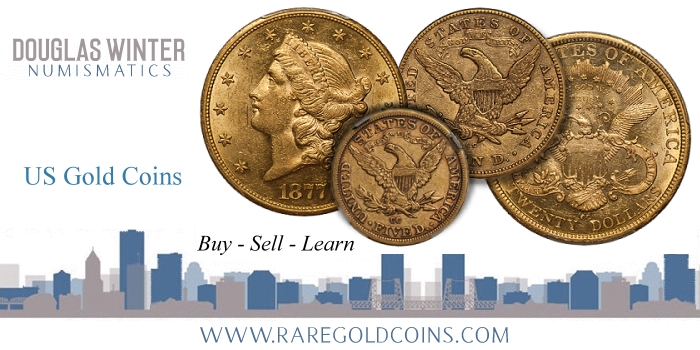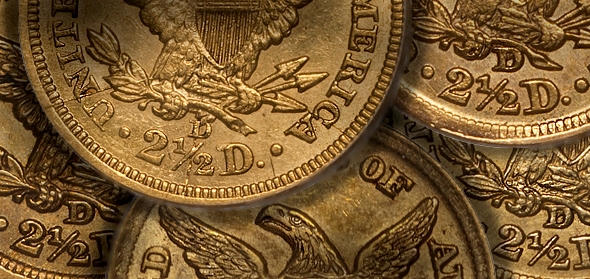By Doug Winter – RareGoldCoins.com
The last article I wrote about the rarity of high-grade Dahlonega half eagles—was enthusiastically received and seemed to resonate with many collectors. This is why I’ve decided that this month’s article will have the same basic theme, but will touch on the subject of Dahlonega quarter eagles.
The Dahlonega mint began production of quarter eagles in 1839 and discontinued this denomination in 1859. There are a total of 20 issues and two major types: the popular one-year Classic Head (1839 only) and the Liberty Head (1840-1859).
In my experience, choice high-grade quarter eagles from this mint are the hardest of the four denominations made in Dahlonega to acquire. While there are a few dates which are reasonably available in high grades (in this case, “high-grade” is defined as coins grading AU55 and above), many quarter eagles from this mint are very seldom found in high grades and even less often with original color and choice surfaces.
As I mentioned in the first article in this series, the existence of CAC is a good way to quantify the rarity of certain issues in higher grades. CAC rewards coins which are choice and even though the sample size is not extremely high, enough choice Dahlonega gold coins have been submitted to this service I order to gain meaningful insights into rarity.
The following chart shows the number of high-grade Dahlonega quarter eagles which have been approved by CAC as of the beginning of April 2015. The findings were very surprising to me, and I will analyze them later this article.
High-Grade Dahlonega Quarter Eagle CAC Populations
| Date | AU55/AU58 | Mint State | Total |
| 1839-D | 4 | 1 | 5 |
| 1840-D | 4 | 0 | 4 |
| 1841-D | 1 | 0 | 1 |
| 1842-D | 5 | 0 | 5 |
| 1843-D (1) | 11 | 3 | 14 |
| 1844-D | 9 | 5 | 14 |
| 1845-D | 2 | 2 | 4 |
| 1846-D | 6 | 1 | 7 |
| 1847-D | 14 | 1 | 15 |
| 1848-D | 7 | 1 | 8 |
| 1849-D | 8 | 1 | 9 |
| 1850-D | 12 | 1 | 13 |
| 1851-D | 2 | 1 | 3 |
| 1852-D | 1 | 1 | 2 |
| 1853-D | 3 | 1 | 4 |
| 1854-D | 2 | 0 | 2 |
| 1855-D | 2 | 1 | 3 |
| 1856-D | 5 | 0 | 5 |
| 1857-D | 2 | 0 | 2 |
| 1859-D | 6 | 2 | 8 |
Notes:
a: these figures include both the Small D and Large D mintmark varieties
b: these figures include both the D and D/D mintmark varieties
Let’s analyze each date in the series using information from my third edition of Gold Coins of the Dahlonega Mint, 1838-1861, as well as personal observations of three decades of specialization in Dahlonega coinage.
1839-D. As with many first-year-of-issue gold coins, the 1839-D quarter eagle appears to have been saved as souvenirs and there are a number of nice higher grade pieces known including at least five separate coins in MS63 to MS64. I would have expected more than one Uncirculated 1839-D to have been approved by CAC and I’m also pretty surprised that only four AU55 to AU58 have been approved. I attribute this more to the fact that a number have yet to have been seen by CAC then they have been sent in but were rejected.
1840-D. The 1840-D is hands down one of the rarer quarter eagles from this mint in higher grades and I am very surprised that three coins graded AU55 have so far been approved by CAC. It is possible that this number is slightly inflated by resubmissions but, come to think of it, I recall having seen at least two separate AU55 1840-D quarter which were CAC approved. The indisputable finest known, an NGC MS62 from the Duke’s Creek collection, would almost certainly have been approved by CAC; I am assuming it has yet to be seen by the Lords of Stickers.
1841-D. I’ve probably owned at least five or six high grade 1841-D quarter eagles over the years which were nice enough to sticker at CAC, yet only one high-end AU has been approved thus far. Hmmm… What this tells me is that the majority of choice 1841-D quarter eagles have either been destroyed by coin doctors in the recent years (shudder…) or the pocket of nice examples of this date for whatever reason(s) have yet to have been submitted. Always remember that there are plenty of nice branch mint gold coins which for whatever reason have yet to make it to CAC.
1842-D. I am surprised that five high-end AU’s have stickered, but I think the fact that three of them are AU58’s is a little red flag. I’m going to go out on a limb here and guess that at least one of these is a duplicate submission. In my experience, a CAC quality AU58 1842-D quarter eagle is a very rare coin, and given CAC’s strict standards it seems unlikely that three coins exist. Always take population figures with a grain of salt as they rely on dealers to properly maintain them, and this is beyond the pay grade of most of my peers.
1843-D. This date is among the most available Dahlonega quarter eagles in high grades and I’ve handled dozens of nice coins. Even so, I’m surprised that 11 high-end AU and three Uncirculated pieces appear in the CAC population. This brings me to an important point. It seems, when comparing the pop figures at CAC for Dahlonega quarter eagles and half eagles that perhaps the standards for smaller coins are more lax. Let’s say CAC is fanatical about marks: on small coins, marks aren’t as big an issue, hence more small coins might qualify for stickering. True or not, just a passing thought…
1844-D. That the population at CAC is comparatively high for this date isn’t really a surprise. That it includes no less than five coins in Uncirculated is surprising. I also think the CAC population for this date in AU55 is inflated as well.
1845-D. Quoting myself, on page 121 of my Dahlonega book, I state about the 1845-D quarter eagle: “locating a high-grade example with good eye appeal is extremely difficult.” Not to toot my own horn too much but the CAC figures seem to validate this observation of mine. Only two high-grade AU’s have been beaned to date.
1846-D. Having seen and owned some really nice 1846-D quarter eagles, I’m surprised that only one Uncirculated piece has been approved by CAC. Removing the small group of 1846-D/D quarter eagles approved by CAC, the number of qualified normal mintmark pieces is surprisingly small.
1847-D. Even before I studied the CAC numbers I was reasonably certain that this would be the most available D mint quarter in higher grades with CAC approval. This date tends to come nice and I have owned some simply spectacular AU55 and AU58 pieces. I’m not surprised that only one Uncirculated example has been beaned thus far; the 1847-D is still a rare coin in choice, original Uncirculated grades.
1848-D. This is another date that is comparatively available in nice AU. There are at least four known graded MS63 and only one, thus far, has been approved by CAC. Given that at least two of these are recolored I doubt if we will see many more higher grade 1848-D quarter eagles with CAC stickers.
1849-D. Another self-quote (page 136) “There are possibly fewer than a dozen examples known which have very good eye appeal.” Then why has CAC approved eight in the higher AU grades and another in Uncirculated? Either CAC’s standards are a bit slack on this date (doubtful) or the four each in AU55 and AU58 are inflated by resubmissions (likelier). I still don’t see many examples of the 1849-D quarter eagle which are nice.
1850-D. Back in the day we considered the 1850-D to be a scarce date, but the PCGS/NGC and CAC populations are proving us wrong. With 12(!) in AU55 to AU58 approved by CAC, this is clearly one of the more available dates in higher grades; even if the population figures are inflated as I believe them to be.
1851-D. Beginning with this issue, the quality of strike for Dahlonega quarter eagles becomes a problem. Luckily, the graders at CAC seem to recognize the difference between strike and wear and see these coins the “right way.” That said, only three 1851-D’s have received the coveted green bean, and this surprises me as I have handled some pretty nice examples of this date.
1852-D. The extremely low CAC population of this date is even more of a surprise to me than the 1851-D. I am aware of seven different Uncirculated examples and I would have thought that more than one (so far) would have seen CAC approval. This is also the case with AU55 to AU58 coins, as there are a bunch graded and some are quite nice for the issue.
1853-D. Quoting myself yet again, “this is a date which is very rarely seen with good eye appeal.” CAC’s figures seem to agree with this as only three Choice AUs and one Uncirculated (MS62) have been approved thus far. My gut feeling is that these numbers won’t change much s really nice 1853-D quarter eagles are really rare.
1854-D. As we head to the home stretch, we run into three rare issues: the 1854-D, 1855-D and 1856-D. All are rare from an absolute sense, and they are also rare from the standpoint of appearance. The 1854-D is an issue that comes with poor strikes and poor planchets, and many have been cleaned or processed. It’s not a surprise that CAC has approved just two in Choice AU and none in Uncirculated, but there will likely be a few more stickered in the coming years.
1855-D. This issue is also found with appearance problems and probably 90+% of the examples in holders have “issues” of some sort. The CAC population seems about right to me and the only Uncirculated coin with CAC approval (a PCGS MS63 which I purchased at auction in 2012), is a freak coin which probably shouldn’t even exist.
1856-D. I was stunned to learn that five Choice AU 1856-D quarter eagles had been approved by CAC. Interestingly, four of these grade AU58 which suggests a few resubmissions may exist. This is an issue which even I have trouble grading (due to strike issues and planchet problems) so I find it very interesting that CAC has liked this many 1856-D quarter eagles.
1857-D. I expected this relatively available date to have a pretty high CAC population and I was very surprised at how few have been approved so far. I expect to see more approved in the future, especially in Uncirculated where more than a dozen exist; at least a few of these have to be nice enough to sticker, right?
1859-D. And, I expected this date to have a lower CAC population as most of the Choice AU’s and Uncirculated examples I’ve seen have been marginal for the grade.
After analyzing these figures and applying them to the Dahlonega quarter eagle series, I have the following points to ponder:
- CAC population figures for Dahlonega half eagles tended to be lower than I expected, but they were higher than I expected for quarter eagles from this mint.
- The population figures for D mint quarter eagles seem to show some upward skewing due to resubmissions. This is going to be a problem for CAC figures from here on out, just like it is for NGC and PCGS.
- How do quarter eagle vs. half eagle CAC population figures compare for other branch mint gold coins? This is a project I will likely investigate over the next few months and will share my findings with you.
Do you have an interest in Dahlonega quarter eagles? I have bought and sold more great Dahlonega quarter eagles than any other dealer and would love to help you build a set, whether it’s nice EF coins or Condition Census examples. You can contact me directly by email at [email protected].

About Doug Winter
 Doug has spent much of his life in the field of numismatics; beginning collecting coins at the age of seven, and by the time he was ten years old, buying and selling coins at conventions in the New York City area.
Doug has spent much of his life in the field of numismatics; beginning collecting coins at the age of seven, and by the time he was ten years old, buying and selling coins at conventions in the New York City area.
In 1989, he founded Douglas Winter Numismatics, and his firm specializes in buying and selling choice and rare United States coins, especially US gold coins and all branch mint material.
Recognized as one of the leading specialized numismatic firms, Doug is an award winning author of over a dozen numismatic books and the recognized expert on US Gold. His knowledge and exceptional eye for properly graded and original coins has made him one of the most respected figures in the numismatic community and a sought after dealer by collectors and investors looking for professional personalized service, a select inventory of impeccable quality and fair and honest pricing. Doug is also a major buyer of all US coins and is always looking to purchase collections both large and small. He can be reached at 214-675-9897.
Doug has been a contributor to the Guidebook of United States Coins (also known as the “Redbook”) since 1983, Walter Breen’s Encyclopedia of United States and Colonial Coins, Q. David Bowers’ Encyclopedia of United States Silver Dollars and Andrew Pollock’s United States Pattern and Related Issues
In addition he has authored 13 books on US Gold coins including:
- Gold Coins of the New Orleans Mint: 1839-1909
- Gold Coins of the Carson City Mint: 1870 – 1893
- Gold Coins of the Charlotte Mint: 1838-1861
- Gold Coins of the Dahlonega Mint 1838-1861
- The United States $3 Gold Pieces 1854-1889
- Carson City Gold Coinage 1870-1893: A Rarity and Condition Census Update
- An Insider’s Guide to Collecting Type One Double Eagles
- The Connoisseur’s Guide to United States Gold Coins
- A Collector’s Guide To Indian Head Quarter Eagles
- The Acadiana Collection of New Orleans Coinage
- Type Three Double Eagles, 1877-1907: A Numismatic History and Analysis
- Gold Coins of the Dahlonega Mint, 1838-1861: A Numismatic History and Analysis
- Type Two Double Eagles, 1866-1876: A Numismatic History and Analysis
Finally Doug is a member of virtually every major numismatic organization, professional trade group and major coin association in the US.
If you are interested in buying or selling classic US coins or if you would like to have the world’s leading expert work with you assembling a set of coins? Contact Doug Winter at (214) 675-9897 or by email at [email protected].





